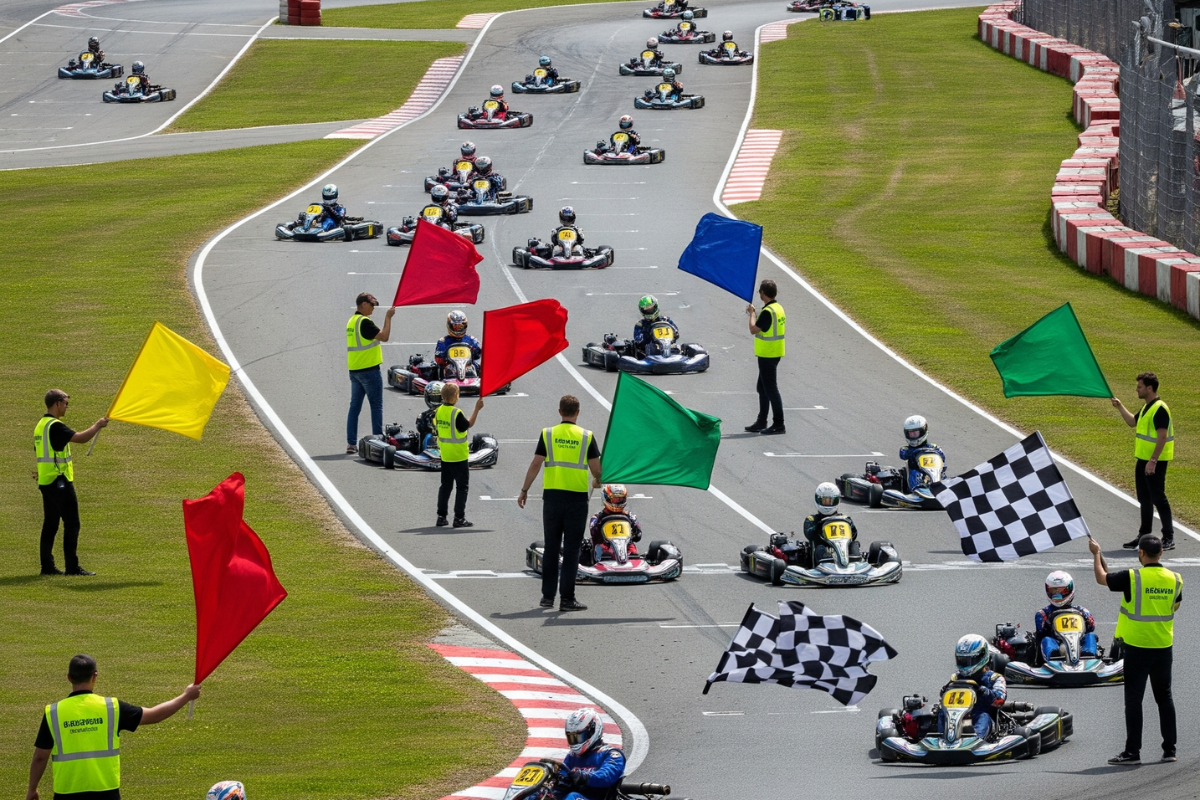Go-karting is an exhilarating and accessible entry point into the world of motorsports. The thrill of speed, the precision of cornering, and the competitive spirit all contribute to its immense popularity. However, just like any form of racing, safety is paramount in karting. One of the most fundamental aspects of ensuring a safe environment on the track is a thorough understanding of karting flag signals. These visual cues, displayed by track marshals, communicate critical information to drivers, ranging from track conditions to immediate hazards and race status. Ignoring or misinterpreting these flags can lead to dangerous situations, penalties, or even serious accidents. This comprehensive guide will meticulously explain each essential karting flag, empowering you to become a safer, more informed, and ultimately, a better racer. Mastering the language of the flags is not just about following the rules; it’s about contributing to a secure and enjoyable experience for everyone on the track.
The Core Communication: Understanding the Basics
Karting flags are the primary means of communication between track officials and drivers. They are typically displayed from marshal posts strategically positioned around the circuit, offering clear visibility to approaching karters. The colors and the way the flags are displayed (stationary or waved) carry specific meanings that every driver must know and react to appropriately.
The Essential Flags Every Karter Must Know
1. Yellow Flag: Caution – Danger on the Track
The yellow flag is arguably the most crucial safety signal in karting. It indicates that there is a hazard on the track that requires drivers to exercise caution.
- Stationary Yellow Flag: A single stationary yellow flag displayed at a marshal post signifies a hazard somewhere on the track within that section or immediately beyond. Drivers should reduce their speed, be prepared for unexpected situations, and hold their position (no overtaking is allowed) until they have passed the incident or the green flag zone.
- Waved Yellow Flag: A single waved yellow flag indicates a more immediate and significant danger on the track right in the section where the flag is being displayed. Drivers must slow down considerably, be prepared to potentially stop, and strictly maintain their position (no overtaking). There may be debris, a spinning kart, or a marshal on the track.
- Double Waved Yellow Flags: This signal indicates a serious and imminent danger that is likely partially or fully blocking the track. Drivers must slow down to a near crawl or be prepared to stop completely. Strictly no overtaking is permitted. This level of caution often precedes a red flag situation.
Driver Action: Upon seeing a yellow flag (either stationary or waved), immediately reduce your speed, stay alert, and be prepared to take evasive action if necessary. Maintain your lane and do not attempt to overtake any other karts until you see the green flag displayed by the next marshal post. Ignoring a yellow flag and overtaking can result in severe penalties.
2. Green Flag: All Clear – Racing Resumes
The green flag is the all-clear signal. It signifies that a previous hazard has been cleared, and normal racing conditions have resumed. It is often displayed at the marshal post immediately following a yellow flag zone.
Driver Action: Once you pass a marshal post displaying a green flag, you can accelerate back to racing speed and resume overtaking.
3. Red Flag: Stop – Immediate Danger
The red flag is displayed in the event of a serious incident or hazardous track condition that necessitates the immediate cessation of the current session (practice, qualifying, or race).
Driver Action: When a red flag is shown, drivers must immediately slow down safely and come to a complete stop in a safe area on the side of the track or as directed by the marshals. Overtaking is strictly prohibited under a red flag. Drivers will typically be directed to return to the pit lane or a designated holding area.
4. Blue Flag: Approaching Faster Kart – Yield
The blue flag is shown to a driver who is about to be overtaken by a faster kart, typically during a race when lapping is occurring.
Driver Action: When you see a blue flag being waved, it indicates that a faster kart is approaching from behind and intends to pass. You should maintain your racing line and allow the faster kart to pass safely and cleanly at the earliest opportunity. Avoid making sudden or unpredictable movements that could impede the overtaking maneuver. This flag promotes smooth racing and prevents slower drivers from unnecessarily holding up faster competitors.
5. Black Flag: Penalty – Report to Pits
The black flag is a direct instruction to a specific driver to immediately return to the pit lane. It is usually accompanied by a marshal pointing the flag and displaying the driver’s race number.
Driver Action: If you see the black flag displayed with your race number, you must safely and promptly return to the pit lane. This flag typically indicates that you have committed a rule infraction, your kart has a technical issue that needs addressing, or you have been disqualified from the session. Failure to heed a black flag can result in further penalties or exclusion from future events.
6. Black Flag with Orange Circle (Meatball Flag): Mechanical Problem – Return to Pits
This specific flag, the black flag with an orange circle (often called the “meatball” flag), is shown to a driver whose kart has a mechanical problem that could pose a danger to themselves or others (e.g., loose bodywork, fluid leak).
Driver Action: If you see this flag displayed with your race number, you must immediately return to the pit lane for inspection and repair of the identified mechanical issue. You will not be allowed to rejoin the session until the problem has been rectified and deemed safe by the track officials.
7. White Flag: Last Lap
The white flag is displayed to signal the start of the final lap of a race or timed session.
Driver Action: Upon seeing the white flag, drivers are aware that they are on the last lap and should drive accordingly. It’s often a time for final pushes and strategic maneuvers, but safety should still remain a priority.
8. Checkered Flag: Race Finished
The checkered flag, consisting of black and white squares, is displayed to signify the end of a race or timed session.
Driver Action: Once you cross the finish line while the checkered flag is being waved, you have completed the race or session. You should then slow down safely, maintain your lane, and proceed to the designated cool-down area or pit lane as instructed by track officials. Overtaking is not permitted after the checkered flag.
The Importance of Knowing and Reacting Correctly
Understanding these karting flag signals is not merely a suggestion; it is a fundamental requirement for safe participation in the sport. Correctly interpreting and reacting to these visual cues can prevent accidents, injuries, and penalties. It demonstrates respect for the rules, the track officials, and your fellow competitors.
- Safety First: The primary purpose of flags is to alert drivers to hazards and ensure a safe racing environment. Incorrect reactions can exacerbate dangerous situations.
- Avoiding Penalties: Ignoring flag signals, particularly yellow and black flags, can result in significant penalties, including time deductions, grid position penalties, or even disqualification.
- Maintaining Race Flow: Properly yielding to blue flags helps maintain the flow of the race and prevents slower drivers from unduly hindering faster competitors.
- Respect for Officials: Acknowledging and obeying flag signals demonstrates respect for the track marshals and their crucial role in ensuring safety.
Tips for Mastering Karting Flag Signals
- Study the Rules: Familiarize yourself with the official rulebook of the track or series you are participating in. Flag meanings are generally consistent but it’s always good to confirm any specific interpretations.
- Pay Attention: Always be vigilant and actively scan the marshal posts as you navigate the track. Don’t solely focus on the kart in front of you.
- React Immediately and Decisively: When you see a flag, react promptly and in accordance with its meaning. Hesitation can be dangerous.
- Practice Recognition: During practice sessions, make a conscious effort to identify and understand the flags being displayed.
- Ask Questions: If you are unsure about the meaning of a flag or how to react, don’t hesitate to ask experienced karters or track officials for clarification.
- Observe Others: Pay attention to how experienced drivers react to different flag signals.
Your Role in Track Safety
As a go-karter, you are an integral part of the safety ecosystem on the track. Your understanding and adherence to karting flag signals are crucial for ensuring a secure and enjoyable environment for yourself and everyone around you. By taking the time to learn and master the language of the flags, you are not only becoming a more skilled racer but also a more responsible and safety-conscious participant in this thrilling sport. So, next time you’re on the track, keep your eyes peeled, understand the signals, and remember that safety, guided by the flags, is always the top priority.

Ramon Splinter is a passionate go-kart enthusiast and expert who shares valuable tips and insights on Zyorb, a blog dedicated to karting enthusiasts. With years of experience on the track, he specializes in helping beginners and seasoned drivers improve their skills, optimize their karts, and master racing strategies. His articles combine technical knowledge with practical advice, making go-karting more accessible and exciting for all.

